Wild mushroom identification entails more than just examining the mushroom itself, it requires looking at the surrounding habitat as well.
Fungi are so inextricably linked to their surroundings. Thus mushroom hunting is easier if you recognize habitat details. You’ll greatly increase your chances of finding a favorite mushroom if you know it grows near a certain tree!
Since trees and mushrooms enter commonly into relationships, we’ll begin by discussing the importance of trees and mycorrhizal fungi. Then we’ll look at soil composition and other important habitat factors.
Mushroom and Tree Relationships
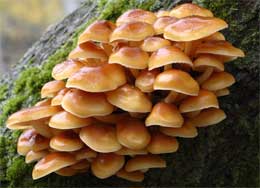
Nearby trees are arguably the most important things to note regarding wild mushroom identification. Sometimes this will be more obvious, with your mushroom fruiting directly on an easily identifiable tree. However, if your specimen is on the ground, investigate what trees are nearby.
Wild mushrooms that fruit on the ground and have a symbiotic relationship with nearby trees are referred to as mycorrhizal fungi. In a mycorrhizal relationship, the fungal mycelium joins to the roots of the host tree either intracellularly or extracellularly. This gives the fungus access to carbohydrates that the tree produces (such as glucose) and gives the tree a larger surface area to absorb water and nutrients. In a sense the fungus “extends” the tree’s roots.
Thus knowing surrounding trees can greatly aid in wild mushroom identification. The relationship between trees and mycorrhizal fungi is difficult to impossible to duplicate in a lab, so the woods may be your only hope for finding certain species. Some famous mycorrhizal mushrooms you may be interested in include all species of truffles, black trumpets, chanterelles, boletes, and the hedgehog mushroom.
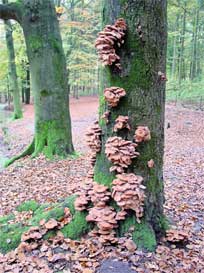
You’ll often see a mushroom directly on a tree rather than on the ground. In this case it may be classified as saprotrophic (a scavenger feeding on a dead tree), parasitic (a parasite slowly damaging a living tree), or a combination of both.
Mushroom and tree relationships, especially mycorrhizal ones, are still not fully understood by modern science. Certain species prefer certain trees; so consult a local guidebook for more information about fungus/tree relationships in your area.
So how do you identify a tree? Good question! It is beyond the scope of this website to teach you how to identify trees. For the most helpful tree identification site pertaining to mycology on the web see Michael Kuo’s North American Trees page.
How’s The Dirt?
Another thing to consider with wild mushroom identification is the condition of the soil or ground.
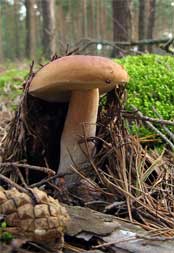
Certain species will fruit in areas where the ground has been “disturbed”. Examples of this are after a forest fire, near old washes, and around other areas of erosion created by man or nature. The delicious black trumpet can often be found near a wash or rivulet. Looking out for ground disturbances can help you locate this elusive delicacy!
Be sure to note soil composition. This may not always be possible, as it may be difficult to find information about what’s in your local dirt! An Internet search or a quick email to a local mycologist or geologist may enlighten you.
Soil composition is important to know because certain species appear under certain soil conditions. The morel mushroom, for example, fruits in areas where the soil contains more lime. Know your local lime deposits, and you may find a secret stash of morels!
Other things to study about the surrounding forest floor:
- Moisture content. Is the ground bone dry or saturated with water? Mushrooms will often fruit in areas where the ground is moist but not soaking wet.
- Decaying matter. This includes leaf litter and pieces of rotting wood. Saprotrophic mushrooms feed on dead organic material, and you’ll often find them on dead logs and ground material.
One final statement about soil: beware of toxins. Mushrooms will absorb toxins from their environment so specimens growing in areas where chemicals are present will often contain these chemicals.
Never eat mushrooms found by the side of any road, near chemical plants or factories, in lawns treated with chemicals, in areas where pesticides are used, and any region where pollution is heavy. Yes, that chanterelle near the chemical plant may be tempting, but best leave it alone.
Wild Mushroom Identification by Season
Temperature, time of year, and light are aspects of habitat to consider as well.
- Make note of the temperature, not only at the time of mushroom hunting but also at night. Many mushrooms fruit in the early fall, as the nights begin to grow cooler. These cool evenings tend to trigger mycelium to produce mushrooms as they indicate a change in seasons. Observing temperature changes in your environment can tell you when to begin searching for new specimens.
- The time of year is important as some mushrooms fruit mainly in the fall, others in the spring. The length and conditions of these seasons may change depending on where you live so consult a local guidebook for more information. The most famous example of seasonal fruiting is probably the morel, which is notorious for showing up mainly from April to early June.
- Finally there’s light. Although mushrooms are famous for growing in the dark, most of them need a little light. They don’t use it to produce food, but indirect, sustained light also triggers mushroom production. Many will grow towards the light, called “photosensitivity”.
So the next time you’re trying your hand at wild mushroom identification, remember to look around your prize. Observe the trees, soil, and other aspects of the environment. There’s no telling what you might find next!

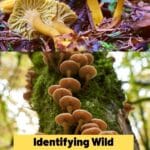
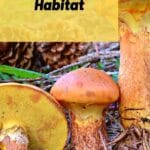
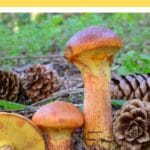

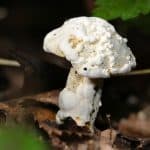
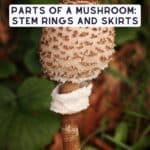
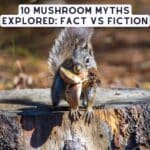
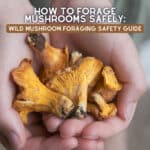
Sharon de Leon says
If I send a photo of a tree mushroom found in a wooded area in northeast Indiana, can yu identify? It is dark reddish brown with a whitish underside that is beginning to yellow after 5 days. It is large like a portobello, approximately 4″ x 3″ wide from the stem where I broke it off a fallen log (black walnut maybe) and very dense.
Jenny says
Hi and thanks for the note — the best thing to do is post it in our group on Facebook. Make sure to read the pinned post about identification requests :-). https://www.facebook.com/groups/340690111324762